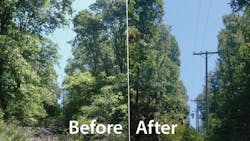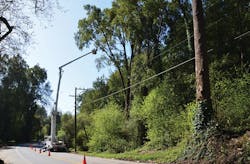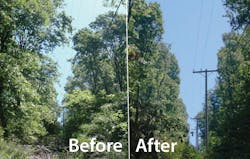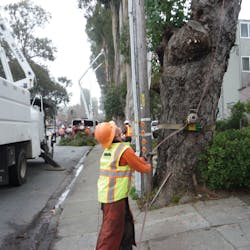PG&E Focuses on Public Safety & Prevention of Tree-Caused Power Outages and Fires
Until 2006, Pacific Gas and Electric Co.’s (PG&E’s) vegetation management program focused primarily on routine maintenance work to simply maintain compliance with California mandates pertaining to vegetation line clearance. Such routine vegetation work includes tree pruning and removal along distribution and transmission lines, as well as vegetation clearing around subject poles.
Improvements to system average interruption frequency index (SAIFI), defined as the average number of outages a customer experiences, generally came as a result of mitigating hazard trees before they fell into high-voltage facilities and preventing outages caused by vegetation actually growing into conductors.
However, the utility wanted to significantly improve the overall safety and reliability of its system, and further reductions to the number of vegetation-related outages would be another step toward this goal.
Although there may have been some correlation between routine vegetation maintenance work and a possible reduction in SAIFI from 1999-2006, it was clear a more proactive approach was needed to specifically target the vegetation-related outages that impacted reliability as reflected by SAIFI. To complement its vegetation management routine maintenance work, PG&E developed its vegetation management system reliability program in 2007. The goals of this five-year program were three-fold:
- Reduce vegetation-related SAIFI on PG&E distribution circuits by more than 50% within five years
- Reduce the possibility of fire ignition when trees or branches fall into power lines
- Improve public safety and customer satisfaction by providing safe and reliable power to its customers.
Vegetation-Related SAIFI
PG&E contractors were tasked with prescribing work on failure-prone trees along predetermined distribution line sections throughout the utility’s service territory, based on the occurrence of past vegetation-related outages. By the end of 2007 — the first year of the program — more than 8,600 trees had been pruned or removed along critical sections of PG&E’s distribution circuits. More importantly, vegetation-related SAIFI began a downward trend that continues today.
The year 2012 marked the sixth year of the reliability program and the results are encouraging:
- PG&E’s vegetation-related SAIFI marked a low of 0.087 in 2011, and it decreased from 0.125 in 2006 to 0.103 in 2012 overall.
- Where reliability projects have taken place, vegetation-related outages have decreased 44% on average.
- 85% of PG&E customers who have participated in the program rated the program’s work as good, very good or excellent.
To achieve this success, the reliability program pruned or removed more than 107,000 trees from 2007 to 2012.
Additionally, as part of vegetation management system reliability program, the utility started a pilot project in 2011 called the Outage Risk Reduction (ORR) project. The ORR project focuses on fire-risk-reduction tree work by primarily using Davey Tree Surgery Co.’s Jarraff and Asplundh Tree Experts’ Sky Trim instead of traditional climb or lift tree crews. Through the ORR project alone, more than 14,000 trees were trimmed or removed in 2011 and 2012.
Which Trees to Work
With an estimated 50 million trees adjacent to 113,000 miles (181,856 km) of overhead PG&E distribution lines, determining which trees to work is a definite challenge. However, PG&E has streamlined its data analysis process to quickly and efficiently determine feasible projects.
PG&E monitors and investigates about 3,000 vegetation-related outages that occur during any given year. Vegetation outage investigations help PG&E to compile information detailing field conditions, outage locations and, more importantly, species-specific tree data. To date, more than 20,000 tree and branch failures related to outages on PG&E distribution circuits have been recorded and stored in the PG&E vegetation management outage database. The outage database provides the foundation of PG&E’s data analysis of tree failures and is a key tool for creating species-specific tree work prescriptions in the field.
In addition to species-specific prescriptions, PG&E uses its outage database to prioritize segments of distribution lines with high rates of vegetation-related outages. Along high-priority line segments, individual trees are evaluated and species-specific tree work is prescribed to mitigate the species’ likely failure profile.
This method allows PG&E to efficiently identify species likely to fail in a way that matches how a species fails. For example, the typical work prescription on a coast redwood would be to prune all limbs that overhang high-voltage conductors, because redwoods commonly shed branches. On the other hand, gray pines are generally prescribed for removal because of their propensity to fail by the roots, trunk or large branches.
2013 and Beyond
The vegetation management system reliability program has been renamed the vegetation management public safety and reliability (PS&R) program. As the new name implies, PG&E is focusing even more on public safety with regard to vegetation-related outages and potential associated fires. Specifically, PG&E is working to reduce significantly the incidents of downed power lines, internally referred to as wires down, resulting from branch and tree failures. The current expectation is that vegetation-related wires down will decrease 8%, on average, each year over the next four years.
Operational improvements and efficiencies in the PG&E vegetation management routine maintenance program allows the PS&R program to be entirely self-funded as a result of the success of PG&E’s 2007 vegetation management improvement initiative. In 2013, the PS&R program will expand its efforts by planning to address nearly 50,000 trees in the PG&E system — a 75% increase from 2012.
Workload Alignment Strategy
Recognizing that multiple visits from PG&E employees or contractors throughout the year can be a burden on PG&E customers, the PS&R inspections and tree work will be aligned with annual routine maintenance work in 2013. This means, when practicable, PG&E tree contractors will visit a customer once to carry out all prescribed work on the customer’s property. Fewer customer visits should positively impact customer satisfaction while the workload alignment strategy will help to increase operational efficiencies further.
PG&E’s vegetation management system reliability program accomplished much of what was expected and built a foundation of success from which the PS&R program could begin. Preventing the possibility of fire ignition from wires down and improving SAIFI for PG&E customers will be a challenging endeavor going forward. Nonetheless, it is a challenge PG&E will overcome to provide its customers with safe, affordable and reliable power.
About the Author:
Eric Woodyard ([email protected]) is the senior program manager of Pacific Gas and Electric’s Vegetation Management Public Safety and Reliability program.



